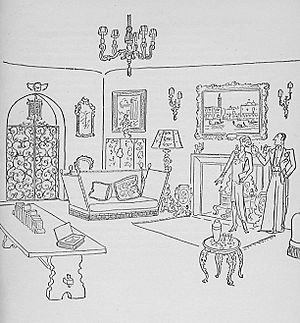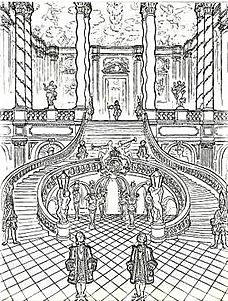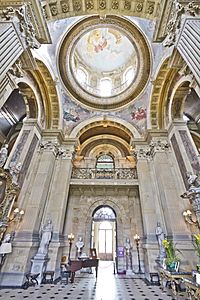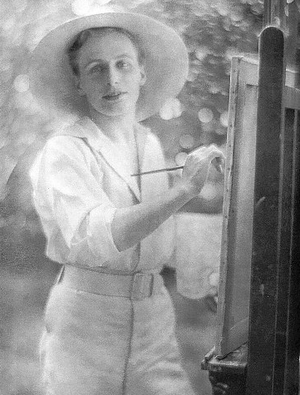Curzon Street Baroque facts for kids
Curzon Street Baroque is a 20th-century inter-war Baroque revival style. It manifested itself principally as a form of interior design popular in the homes of Britain's wealthy and well-born intellectual elite. Its name was coined by the English cartoonist and author Osbert Lancaster, as Curzon Street in Mayfair was an address popular with London high society. While previous forms of Baroque interior design had relied on French 18th-century furnishings, in this form it was more often than not the heavier and more solid furniture of Italy, Spain, and southern Germany that came to symbolise the furnishings of new fashion.
While in vogue, roughly between 1927 and 1939, Curzon Street Baroque was also disparagingly known as "Buggers' Baroque" or "Decorators' Baroque". This was, according to author Jane Stevenson, because "a statistically implausible number of important men and women, and their decorators in the interwar arts, were gay". Among them were many of the leading writers, poets, and designers who used and promoted the style.
Contents
Naissance
True Baroque architecture, internal and external, employs architectural drama and surprise, chiaroscuro (light and shadow) pulse and a diversity of fanciful and joyous shapes and curves. However, Baroque has never been truly to the British taste. Having evolved as a derivative form of Renaissance architecture, in mainland Europe, in the mid-17th century, it made a brief appearance in Britain, at the beginning of the 18th century. It was pioneered in Britain, most notably, by Sir John Vanbrugh with his three principal projects Blenheim Palace, Castle Howard, and Seaton Delaval. Of these three monumental houses, only the earliest, Castle Howard, employs the true fanciful style of Baroque seen in mainland Europe; the remaining two rely heavily on mass and chiaroscuro to display their baroque qualities. In Britain, the style soon fell from fashion, and by the 1760s was replaced by the more serious and severe Neoclassical architecture. Osbert Lancaster put the British dislike of Baroque down to a national "ill-concealed dislike" of "cleverness", a virtue essential for any successful Baroque architect.
As a revival style, Baroque made a brief reappearance at the beginning of the 20th century, but in a confused form known as Edwardian Baroque architecture. As a revived form of interior decoration, it really dates from the 1924 publication of Sir Sacheverell Sitwell's book Southern Baroque Art, which concentrated on the ornate Baroque style then regarded as vulgar and excessive. Sitwell with his two siblings, Edith Sitwell and Osbert Sitwell, known collectively as the Sitwells, formed an identifiable literary and artistic clique around themselves in London during the period 1916 to 1930. The book's publication sparked an artistic reevaluation of the style. The painter Rex Whistler developed a Baroque influence to his work, while the society photographer Cecil Beaton has been described as full of "Baroque playfulness." This influence was soon picked up by the leading high society decorators of the period, who developed a pared-back 20th-century version of Baroque. Osbert Lancaster, a satirist, author, and cartoonist, then named it Curzon Street Baroque (Curzon Street being one of London's smartest addresses).
Often mixing antique and modern furniture in the same room, Curzon Street Baroque, has been described as a rejection of Modernism. However, as a reformation style, it was more a rejection of the dark and cluttered Victorian style. The opinion of Victorian Architecture and style was at an all-time low, with Osbert Lancaster's fellow wit and contemporary, PG Wodehouse, stating: "It is pretty generally admitted that few Victorians were to be trusted within reach of a trowel and a pile of bricks." Curzon Street Baroque certainly avoided the straight clean lines of Modernism and the dark woodwork of the Victorian era in favour of curves of "overwrought iron and Knole sofas, forests of twisted baroque candlesticks and pickled-oak occasional tables with the early southern-German look inspired by the arty Sitwells." Walls were painted pastel colours, often a shade of green, and where the patrons could afford it, at least one "feature panel" was installed in a room. These were large paintings or murals, often let into the newly repainted panelling, often in the form of trompe-l'œil. In the dining room at Sandringham, the panels were valuable tapestries given by King Alfonso XII of Spain.
Externally, with a few exceptions, the revival style was less popular. However, the architect, Clough Williams-Ellis, would adopt a colourful Northern Italianate pastiche Baroque theme as the style for the design of Portmeirion. The late 17th-century Upton House was remodelled by the architect Percy Morley Horder between 1927 and 1929 for the 2nd Lord Bearsted with some external baroque motif, but chiefly the Baroque was confined to the interior.
Components of the style

According to Osbert Lancaster, key constituents and elements of Curzon Street Baroque included Venetian hand-painted furniture and art in the style of Canaletto (often of doubtful provenance). An ecclesiastical air could also be employed, which could be achieved by twisted Baroque candlesticks, old leather bound hymn books hollowed out to become cigarette boxes, and ancient gilt prie-dieux transformed into cabinets for the disguising of gramophones. Further objets d'art would include plaster saints suffering torment in coverings of iridescent paint.
Lancaster also stated that French furniture, much of it gilt and with cabriole legs, which was such a large part of 17th-, 18th-, and early 20th-century Baroque furnishings, was no longer considered fashionable. Lancaster's own illustration of the style includes a French style occasional table with cabriole legs. However, such furniture was still used within the style by some decorators including Elsie de Wolfe, who worked in a particularly feminine and flamboyant style.
An important feature of the style, not always possible due to the expense, was the feature wall. Often this was a trompe-l'œil mural meant to create the Baroque element of surprise and illusion. The era's most celebrated painter of these was Rex Whistler, most notably his Tent Room at Port Lympne and his Italian panorama in the dining room at Plas Newydd of 1938. The setting of such murals and other paintings and tapestries was often in panels rather than frames, a Baroque feature dating from the 17th century. It was also acceptable to mix old and new furniture together in the same room. A further feature, although often not present because of cost or architectural restraints, were wrought iron gates in place of doors or window shutters.
Examples
Outside of London, Baroque was frequently employed by the newly rich when rebuilding their newly acquired country houses. When the wealthy merchant banker Vivian Smith, 1st Baron Bicester, acquired Tusmore Park, Oxfordshire, in 1929, he immediately brought in the architects Imrie and Angell to sweep away the heavy Jacobean woodwork and introduce a Baroque interior, which culminated in the staircase hall, with a double staircase, heavy with wrought iron, segmented arches, and a gilded chandelier hanging from a ceiling embellished with a gilded starburst. At Upton House, Lord Bearsted's architect continued his baroque theme within, installing ornate overmantels, columns, panelling, and a curved interior balcony, all in the fashionable pared-back Baroque style.
One of the best examples of Curzon Street Baroque can be found in the Italian Drawing Room at Eltham Palace; although the interior is of an art deco design, Curzon Street Baroque was chosen for the principal drawing room. The house, a historic former royal palace, was vastly extended between 1933 and 1936 for Stephen Courtauld and his socialite wife Virginia. In the Drawing Room, their interior designer Piero Malacrida de Saint-August installed all the requisite features of the style, such as antique wrought iron from Spanish churches, acquired from Mayfair antique shops, heavy furniture, and gilt light fittings with parchment lampshades.
Disparaging descriptions
The parodying and disparaging of new architecture and styles in the 1930s was a fashionable thing to do. Evelyn Waugh mocked the modern movement in his novel Decline and Fall, when he described the new country house of Margot Beste-Chetwynde, King's Thursday, as "in the style of a chewing-gum factory." While closer to Curzon Street Baroque, he parodies one of its designers, Lady Sybil Colefax, as the horrendous interior designer Mrs Beaver in A Handful of Dust.
The style was often described as Decorators' Baroque, as it was, more often than not, developed by interior decorators rather than architects. Many of the style's components were portable ornaments rather than fixtures and mortar. The rise of the style could also be attributed to the huge increase and popularity in interior decorators: in 1912, the London Post Office Directory listed only four, but by 1920, this number had risen to 122, over 60 of them in Mayfair, close to Curzon Street. Another type of decorator also evolved in this period; these were often furniture dealers too, so it was possible for one decorator to completely alter a room's style, rather than just change the colours of the walls and fabrics, all with minimal stress to the patron.
Associated with the style
- William Bruce Ellis Ranken (1881–1941)
- Elsie de Wolfe (1859–1950)
- Sybil Colefax (1874–1950)
- Osbert Sitwell (1892–1969)
- Sacheverell Sitwell (1897–1988)
- Osbert Lancaster (1908–1986)
- Rex Whistler (1905–1944)
- Piero Malacrida de Saint-August (1889-1983)
- Philip Tilden (1887–1956) Designed the classical swimming pool and garden at Port Lympne.
Decline
The outbreak of World War II in 1939 put an end to unnecessary, luxurious redecoration. However, by the time Lancaster had defined Curzon Street Baroque in 1939, he was already documenting other newer styles: Aldwych Farcical–a pastiche of 19th-century country house interiors; Stockbroker Tudor–heavy oak furniture and four-poster beds; and Modernistic–a style today known as 1930s Art deco. It is art deco which today defines the 1930s and came to be seen as "expressing all the vigour and optimism of the roaring twenties, and the idealism and escapism of the grim thirties." Curzon Street Baroque was a brief fashion employed by the wealthy, remembered today only because of its survival in a few of their homes, such as Coleton Fishacre, Eltham Palace, and Upton House, Warwickshire.








